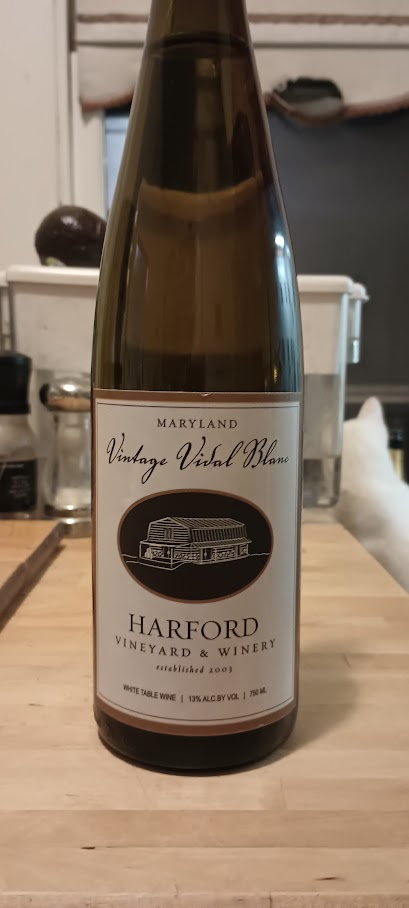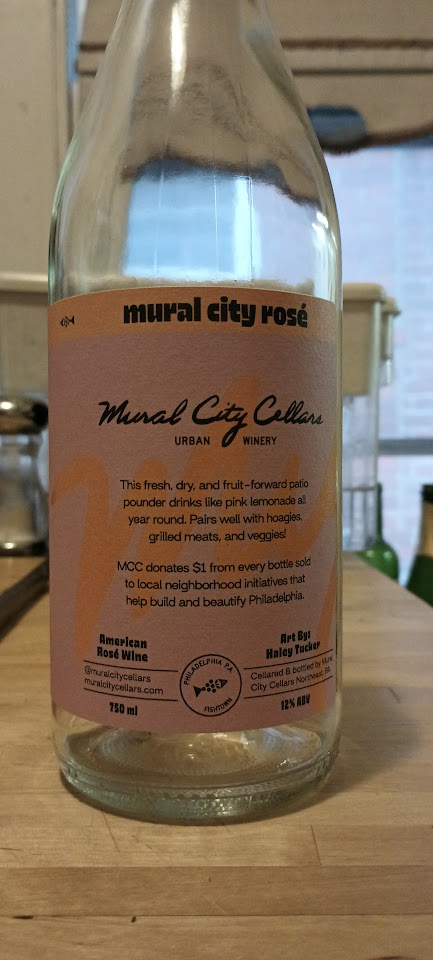American wine production is dominated by California, Washington and to a lesser extent Oregon. Nonetheless, wine is produced in all 50 states, and many of these wines are notable in their own right, offering regional distinctions worthy of further exploration. Indeed, we have previously featured wines of Pennsylvania and the Finger Lakes of New York in previous classes. For this tasting, we expanded the territory for our tasting profiles, delving into wines from states that include New Jersey and Maryland, as well as new ones from Pennsylvania (Philadelphia) and New York State (Long Island).
Overall, the wines were very well received, even those from Maryland, which hardly springs to mind when considering states with an established wine culture. However, the real standouts were the two selection from the North Fork region of Long Island, courtesy of my wine geek friend Kevin, who graciously offered to sell off a few of his prize collectibles for the edification of my students. Cheers and Happy Tasting!
Fiore Traminette
Origin: Pylesville, MD
Varietal: 100%
Traminette
Production/Tasting
Notes: Aromas of citrus, pineapple, pear; flavors of
apricot, grapefruit; hint of honey
Food
Pairing: poultry; seafood; salads; vegetarian fare.
Alcohol:12%
Harford
Vintage Vidal Blanc
Origin:
Forest
Hill, MD
Varietals:
100%
Vidal Blanc
Production/Tasting
Notes: semi-dry; hints of orange zest, grapefruit; floral
notes
Food Pairings: Crab dishes;
pear & Roquefort tarts; crepes
Alcohol:
13%
Mural
City Rosé
Origin:
Erie
County; PA
Varietal:
100%
Chambourcin
Production/Tasting
Notes: Fresh, dry, fruit forward; snappy; zesty.
Food
Pairing: hoagies; grilled chicken; roasted veggies
Alcohol: 12%
Lamoreaux
Landing Yellow Dog Riesling 2021
Origin: Lodi, Seneca Lake, NY
Varietal: 100% Riesling
Production/Tasting
Notes: "Scents of toasted grain, hints of orange and
orange zest. Mildly off-dry, [crisp] flavors of apple and citrus, balanced and
mannered, with limey acidity and the density of poached tuna." Wine & Spirits Magazine, 91 points.
Food
Pairing: Smoked fish; spicy, Asian dishes; Indian curry
Alcohol:
11.1%
Ravines Limestone Springs Vineyard Dry Riesling 2021
Origin:
Geneva,
Seneca Lake, NY
Varietals:
100%
Riesling
Production/Tasting
Notes: Limestone soil; skin contact in tank before
pressing; low temperature fermentation in stainless steel tank; ages on lighter
lees before bottling; dry style, delicate aromatics of tangerine, juicy peach;
flinty, distinct minerality, vibrant acidity. (92 points, Wine Spectator)
Food
Pairing: Spicy Asian fare; dessert dishes
Alcohol:
13.3%
Willam
Heritage Outer Coastal Plain Merlot 2022
Origin:
Mullica
Hill, NJ
Varietal:
100%
Merlot
Production/Tasting
Notes: 10 months in 15% new French oak; Notes of
strawberry; olive; forest floor; herbal hints of fresh thyme, oregano.
Food
Pairing: Burgers; roast beef; ratatouille
Alcohol:
13.5%
Lenz Cabernet Estate Selection 2019
Origin: North Fork, Long Island, NY
Varietal: 100% Cabernet Franc
Production/Tasting Notes: Barrel-fermented in open-ended barrels; on
the nose, woody, earthy, traces of mint, red cherry, violet, cardomom; hint of
vanilla; on the palate, soft, velvety mouthfeel; notes of red plum,
pomegranate, raspberry; unfined, unfiltered.
Food Pairing: Lentil soup; herb-crusted lamb rack; pizza
Alcohol: 12.5%
Paumanok
Grand Vintage Merlot 2013
Origin:
North
Fork, Long Island, NY
Varietal:
100% Merlot
Production/Tasting
Notes: Aged for 15 months in French oak (30% new; 70%
neutral). Delicate aromas of
plums, cola, and licorice with hints of black pepper. The palate is lively,
with creamy, dark fleshy fruit - black cherry, plum; dried herb, autumn leaves;
mushroom. Warm and expansive on the mid-palate, with rustic tannins, leading to
a persistent finish tinged with sweet herbs, hinting at dark earth notes. (93
points, Wine Enthusiast; 93 points Wine Advocate.)
Food Pairing: Mushroom dishes; pasta with pesto or herb sauce; roast
pork;
Alcohol: 13%
Notes
on Wineries
Mural
City Cellars, Philadelphia's first independently
owned urban winery located in Fishtown, produced its first vintage in
2019. Grapes are sourced from small
growers within a 300-mile radius, extending all the way to Erie,
Pennsylvania. The labels are designed by
local artists. The wines tend to be low-intervention and therefore, lean toward
the "natural" style. Wines can
be purchased site for take away or
enjoyed on site in their cozy, comfortable lounge or in the outside patio.
Lamoureux
Landing Wine Cellars, located on Seneca Lake in Lodi, New
York, operates on 119 acres of planted vineyards in 20 different vineyard
blocks. Founded in 1990 and powered by
100% solar energy, the winery produces predominantly Riesling, Chardonnay and
Cabernet Franc, among others including Gewurztraminer, Merlot, Pinot Noir,
Cabernet Sauvignon and Gruner Veltliner.
Ravines
Wine Cellars, which cultivates grapes on both Seneca
and Keuka lakes, offers two separate tasting rooms - one in Hammondsport, the
other outside Geneva. Highly touted for
its Rieslings, the winery also produces very find Pinot Noirs and various red
blends consisting of such varietals as Cabernet Franc, Merlot, Cabernet
Sauvignon and Blaufrankisch. Founded in 2001 by Morton and Lisa Hallgren, Ravines pioneered the bone-dry,
minerally-tinged Riesling which has since become the touchstone of Finger Lakes
wine. Morten grew up on his family's
estate winery in the Cotes de Provence and pursued an advanced degree in
Enology and Viticulture in at a prestigious Ecole in Montpellier before working
at Clos d'Etournel a "Second Growth" winery of great renown in the
Medoc region of Bordeaux. He also served
as chief winemaker for Dr. Konstantin Frank's, before branching out on his own
beginning with a 17 acre plot on Keuka Lake.
Ravines now possesses 130 acres of estate vineyards.
William
Heritage Winery, based in Mullica Hill, also operates a
tasting room in Haddonfield. The winery,
located in the heart of the Outer Coastal Plain AVA in Southeastern New Jersey.
was established in 2001, after Bill and Penni Heritage began cultivating grapes
on their property in 1999. The winery is he family farm on which the grapes are
grown dates back six generations of farming.
Winemaker Kevin Bednar served as assistant winemaker at Gallo as well as
other wineries in Australia, New Zealand and Austria.
Paumanok
Vineyards is a family winery founded in 1983 by Ursula and
Charles Massoud in the North Fork area of Long Island, perhaps the most touted
wine region on the entire island. The winery specializes in estate grown, vinifera-based
wines, including Chardonnay, Riesling, Sauvignon Blanc, Chenin Blanc, Merlot,
Cabernet Sauvignon, Cabernet Franc and Petit Verdot with production limited to
about 12,000 cases annually.
Traditionally dense planting at 1100 to 1400 vines per acre produces
more concentrated fruit which leads to higher quality wines.
Lenz Winery, also based in the North Fork community, was orginally founded in 1978, then purchased by Peter and Deborah Carroll in 1988, who over the years worked to improve the quality of the wines together with head winemakers Eric Fry, Sam McCullough and Tom until they retired and passed on the reins to Thomas Spotteck and Jerol Bailey. The winery employs the techniques of hand harvesting, hand-sorting, low intervention, delayed release and full cluster ripening to enhance the overall quality of the wines.
































